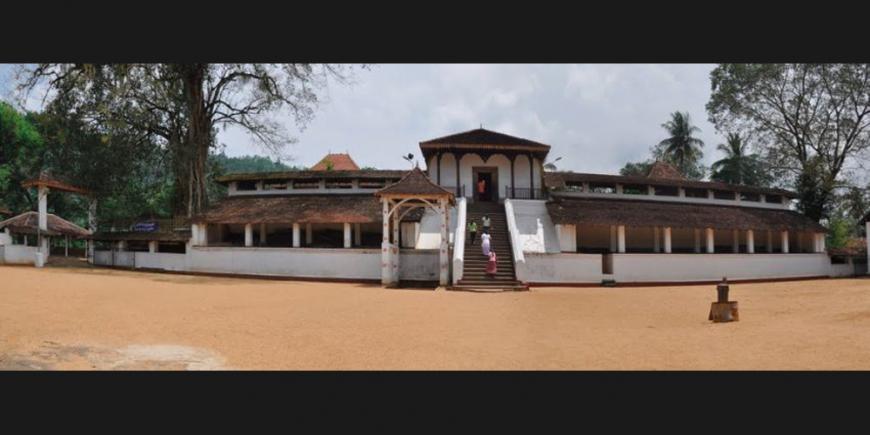
The Maha Saman Devale is located in the Ratnapura district in the Province of Sabaragamuwa. It is considered as the main devale of the deity Saman, except for the devale situated on top of Sri Pada or Adam’s Peak
History says that there was a temple called the Saparagama Vihara during the time of the Anuradhapura Kingdom at the present location of the Maha Saman Devale. Historical records show that a minister, Akryakamadeva who lived during the Dambadeniya period had journeyed to Ratnapura to make a vow for success in gem mining. He vowed that if he was successful he would construct a devale for God Saman. After being successful at gem mining minister Akryakamadeva built the first known devale dedicated to God Saman.
Destruction and construction
During the invasion of the Portuguese many temples which were much venerated by Buddhists were looted. The Maha Saman Devale was a target. It is recorded that the Portuguese built a fort and a church on the grounds of the Maha Saman Devale. During the rule of King Keerthi Sri Rajasinghe of Kandy the church and fort was destroyed and replaced by the Maha Saman Devale. It is believed that the current temple in Ratnapura is the temple constructed by King Keerthi Sri Rajasinnghe.
The Maha Saman devale is also referred to as the Sumana Saman Devale. The present Maha Saman Devale is protected by two walls and is built on two platforms, the upper and lower platforms. Many wood and stone carvings were replaced by much simpler stone pillars due to the financial situation at that time. A Devale for goddess Paththini and a shrine room with a Buddha statue can be seen connected to the Maha Saman Devale. Frescoes and gods were painted on the walls of the Maha Saman Devale using dark and light colours such as black, blue, yellow and red. The Maha Saman Devale was constructed by using a variety of materials including clay, stone dust and bamboo. There is a special rubble stone with a width of one inch and a height of three metres in a glass box. It is like a growing tree and it is known as the Palawena Gala (Growing stone).
 The Esala perahera
The Esala perahera
September is a very busy and festive period of the year for the Ratnapura district. The Esala perahera of the Saman Devale is held annually during this period in honour of God Saman, the god in charge of the Sabaragamuwa province. The Maha Saman Devale Esala perehera first took place during King Parakramabhu VI’s reign. During King Seethawaka Rajasinghe’s rule, the Dalada perahera was added to with a variety of traditional dancers. The perahera rituals begin with apn overnight Pirith ceremony which is then followed by morning alms to bhikkhus.
Next, the ritual of Kap Situweema would take place. The Saman devale perahera includes three main processions. After the Kap Situweema a simple perahera takes place which carries one piece of jewellery each of god Saman and goddess Paththini. This perehera is known as the Kumbal perehera. Once this is over the devala perahera or Veedi perehera will parade through the streets and carry sacred jewellery. This is followed by the Maha Perahera which is a combination of the Dalada, Paththini, Bisodevi, Kumara Deva and Saman Devi perahera.
The Maha perehera which has a large number of drummers, dancers, elephants and the Maha Bamba Kolama will end after the water cutting ritual has been performed. The Sabaragamuwa dance was introduced by the people of Ratnapura and it is the only perahera which consists of female dancing groups other than the normal performances. During the Maha Saman Devale Esala Perehera various rituals take place which include feeding elephants oil cakes (kavum) . This is a unique ritual which can only be seen here. 
Maha Bamba Kolama
The Maha Bamba Kolama is another feature which is unique only to the Saman Devale perahera. The main structure of Maha Bamba is about 15 feet tall with two faces. The Maha Bamba consists of a serene face on one side and a fierce face on the other with a five headed cobra hood on the other.
The two faces indicate the personality of King Rajasingha. The Maha Bamba is dressed in long sleeves and a sarong-like dress. It is believed that the Maha Bamba had first been introduced during King Seethawaka Rajasingha’s rule to represent him when he was unable to attend the perahera. During the perahera days the Devale premises is wrapped in a veil of spirituality, festivity and is full of people from all over the country.
The Saman Devale perahera can be considered as one of the most important festivals in Sri Lanka and in 2019 this was declared as a national event. The Saman Devale in Ratnapura is a national heritage which is enjoyed by locals and foreigners alike. This year’s perahera is the 796th annual Sabaragamu Maha Saman Devale Perahera and the days for it have been fixed as September10-21.
By- Buvindu. A. Manamperi
Grade 7,
Lyceum International School,
Nugegoda.

